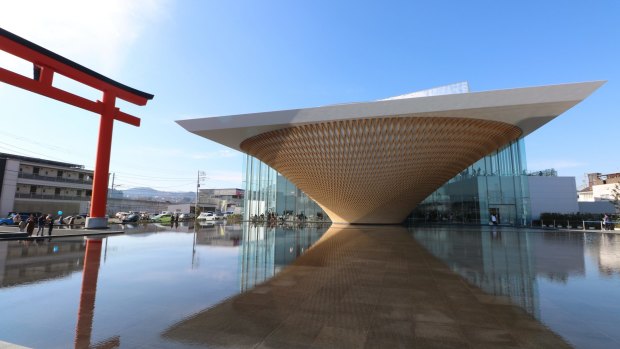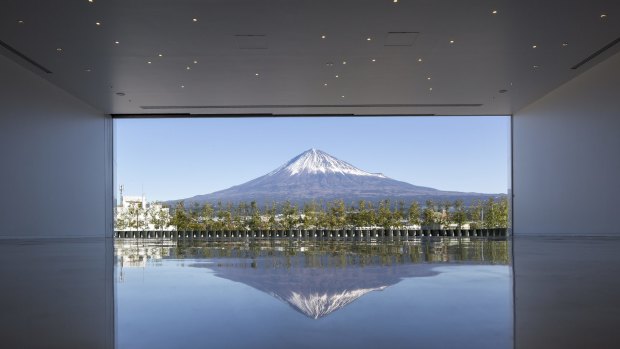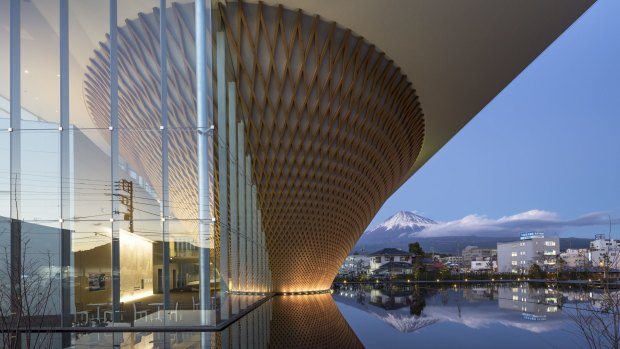This was published 4 years ago
Japan: How to climb Mount Fuji without actually climbing Mount Fuji
By Louise Southerden

The extraordinary facade of this information centre, which opened in late 2017, is an upside-down volcanic cone covered with latticework made from Japanese cypress, harvested from Fuji's slopes. Credit: Fujinomiya City
It's late afternoon, long past the time when a sensible person would have abandoned all hope of reaching the top of Japan's highest mountain. But here I am climbing Mount Fuji, In March, well outside the July to September climbing season. I'll reach the 3776-metre summit in just a few minutes, without needing so much as a down vest. This is all thanks to a little architectural sleight of hand by one of Japan's rock-star architects, Shigeru Ban.
My friends and I had been hiking in the foothills of Fuji that day with En-Ya Mount Fuji Ecotours, learning about birds and volcanic rocks and stealing glimpses of the snowy cone through the trees. It had been a great outdoor day, but a long one, so none of us felt particularly enthused when our guide, Mari, had suggested visiting a museum back in Fujinomiya, our base for two nights.
Arriving at Mount Fuji World Heritage Centre, however, we all spontaneously change our minds – before we even go inside.

At the top, after "sunrise from the summit" views, the ramp reaches its own destination: a white, gallery-like space. There's no art on the walls, just a wide doorway opening onto a broad patio and framing the star of the show: Mount Fuji herself.Credit: Hiroyuki Hirai
The extraordinary facade of this information centre, which opened in late 2017, is an upside-down volcanic cone covered with latticework made from Japanese cypress, harvested from Fuji's slopes. But it doesn't end there; reflected in an enormous ankle-deep pond at its base, the latticework cone becomes a right-way-up Fuji that shimmers with every breath of wind.
"I thought it's impossible to compete with the Fuji mountain in front," Ban has said of his contrary concept, which beat more than 200 rival designs and has since won several architectural awards. "So I did it the other way around."
It's the kind of place that makes you wonder: why is this world-class museum not in Tokyo?

Inside the latticework cone, a white 193-metre spiral ramp simulates the experience of climbing Mount Fuji.Credit: Hiroyuki Hirai
Mari explains why it had to be in Fujinomiya. While most visitors to Mount Fuji approach it from its northern side in Yamanashi Prefecture, close to Tokyo, the small city of Fujinomiya, in Shizuoka Prefecture, is closest to the mountain. It also has strong cultural ties to Japan's sacred strato-volcano: the city's name actually means "Fuji shrine" because pilgrimages up Fuji's holy slopes traditionally started at its Shinto shrine, as far back as the 12th century. There are now four routes up the mountain; the Fujinomiya route remains the shortest and most direct.
Then there's the fact that Fujinomiya is delightfully Fuji-centric.
We'd first seen the mountain from the train as we'd arrived, artfully criss-crossed by power lines. That evening, we'd had uninterrupted Fuji views while soaking in the rooftop onsen of our ryokan.
The next morning, setting off on our hike, we play "spot the Fuji". We look up to see Fuji lording over the city's low-rise sprawl – and down at Fuji-emblazoned fire hydrant covers on the footpaths. We pass shops selling Fuji-shaped cookies, chocolates and soft toys. We even see Fuji-blue traffic cones on the roads, complete with snow-white tops like melted icecreams.
Paying our respects at the city's 400-year-old shrine, officially called Fujisan Hongu Sengen Taisha, we see Mount Fuji framed by cherry blossoms and painted on hundreds of little wooden wishing-tags tied to a rack. When we fill our water bottles from a spring fed by Fuji snowmelt, Mari tells us that despite receiving more than 2 billion tonnes of precipitation every year, no rivers flow down Fuji's flanks. Instead, rain seeps deep and percolates through the mountain's volcanic bedrock, emerging years later ice-cold and mineral-rich. (It also emerges at Shiraito Falls, one of Fujinomiya's prettiest attractions.)
Still, nothing prepares us for the World Heritage Centre that afternoon. Inside the latticework cone, a white 193-metre spiral ramp simulates the experience of climbing Mount Fuji, winding its way up from sea level (the ground floor) to the summit (on level five). The higher we go, the steeper it gets. Unlike the bright, all-white foyer, it's as dimly lit as a cinema, which is exactly what it is: a curving, stand-up cinema where time-lapse video clips shot on Fuji are screened on the walls, transporting us with panoramic views of the surrounding plains, lava fields and oceans of cloud.
Halfway up, a few silhouetted hikers overtake us. I assume they're our shadows – like them, we're wearing daypacks – until they stop to put on rain gear while we keep walking and I realise they're ghosts projected, a clever trick that enhances the feeling of actually being on the mountain.
At the top, after "sunrise from the summit" views, the ramp reaches its own destination: a white, gallery-like space. There's no art on the walls, just a wide doorway opening onto a broad patio and framing the star of the show: Mount Fuji herself.
We're lucky. Fuji is visible only about 100 days a year. The best times to see her are January/February and November/December. In the warmer months, the mountain is also best seen in the mornings, before she loses her head in the clouds.
When Mount Fuji was World Heritage listed in 2013 it wasn't for its natural beauty but for its cultural significance. As a result, the full site includes shrines, pilgrims paths, lakes and waterfalls – as well as the mountain itself.
This is reflected in the World Heritage Centre's exhibition rooms that branch off from the ramp as you follow it back to the ground floor. Although there's information on its geology and the animals and plants found between Fuji's summit and the seabed of the nearby 3000-metre-deep Suruga Bay, most of the exhibits focus on the "human-mountain" relationship.
Interactive displays show how beliefs about Fuji have evolved through the ages and how it has been depicted in art, literature and the media, all over the world. In one airy space with floor-to-ceiling windows, children sit at a large wooden table drawing on Fuji-shaped pieces of paper while their mothers gaze at the mountain.
The last exhibit ponders Fuji's future, particularly when it might erupt again (its last big eruption was in 1707) and how to manage the environmental impact of up to 400,000 people climbing it every summer. Then we exit via a gift shop full of Fuji-themed homewares and architecture books about Shigeru Ban.
Outside again, I take one last look at the inverted Fuji and its reflection – and the real Fuji behind it, still miraculously free of cloud.
"Shigeru has made our world a better place," Tom Pritzker said when Ban won the Pritzker Prize in 2014, referring to Ban's decades of humanitarian work and his innovative use of recyclable, renewable materials – such as in the Cardboard Cathedral he designed for a post-quake Christchurch. No man-made structure can ever improve a mountain like Fuji-san, of course, but in creating Mount Fuji World Heritage Centre, Ban has achieved the next best thing: he has used great architecture to celebrate Japan's great mountain.
FIVE MORE WAYS TO EXPERIENCE MOUNT FUJI
CLIMB
The Fujinomiya trail is the shortest of the four routes to the summit and takes 6-10 hours return. Climbers are asked to donate ¥1000 each for conservation and visitor safety. See fujisan-climb.jp/en/
SNAP
Lake Tanuki, just north of Fujinomiya, is famous for its "Diamond Fuji" photo op. In mid-April and mid-August, the sun rises directly on top of the mountain and sparkles, gem-like, on the water.
HIKE
En-Ya Mount Fuji Ecotours runs guided walks in Fuji's foothills to help locals protect their natural and cultural heritage and will offer all-inclusive glamping experiences from July 2020. See mtfujiecotours.com
GLIDE
Asagiri Para, based in Fujinomiya, offers tandem paragliding flights around Mount Fuji from ¥9500 a person. See asagiri-para.com
SLEEP
The highest beds in Japan are at Fuji's crater rim mountain hut and cost ¥8000 including dinner and breakfast. See fujisanchou.com/guide-for-english/
Qantas flies direct from Sydney to Tokyo Haneda daily and from Melbourne to Tokyo Narita daily. See qantas.com
VISIT
Mount Fuji World Heritage Centre is in Fujinomiya, two hours from Tokyo by train. It's open daily 9am-5pm (6pm in July and August). Entry costs ¥300. There are signs in English throughout and a downloadable audio guide. See mtfuji-whc.jp
STAY
The historic Ogawa-So Ryokan has tatami rooms from ¥12,000 a night a person, including dinner and breakfast. It also has a rooftop onsen with spectacular Fuji views. See ogawasou.jp
Louise Southerden travelled as a guest of Tourism Shizuoka Japan.
Sign up for the Traveller Deals newsletter
Get exclusive travel deals delivered straight to your inbox. Sign up now.